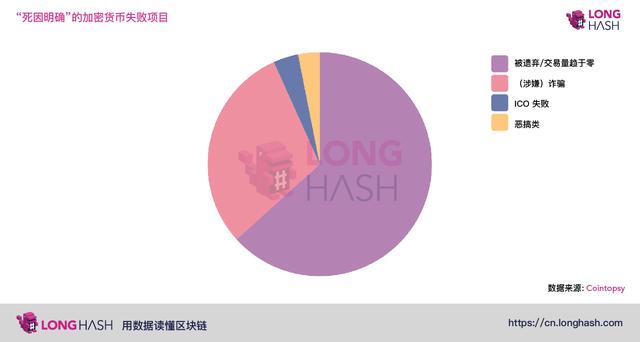Explore the cemetery of cryptocurrencies: Who killed the altcoin?
Source / LongHash
Halloween is coming, and on this holiday we will visit the cemetery of cryptocurrency. I didn't expect the cryptocurrency market to enter the WTO shortly after, and witnessed the death of so many projects. The Coinopsy and DeadCoins websites also made anatomical reports on these projects.
For the sake of entertainment, we took a deeper look at Coinopsy's data, analyzed the reasons for the failure of these projects, and found some interesting things.
Coinopsy has uploaded 700 entries in 8 years and is one of the most comprehensive sites for failed projects. However, that being said, the data is crowdsourced and not very complete, so it may not be as accurate.
- Getting started with blockchain | What is a good digital currency valuation model?
- Building Ethereum 2.0, we have summarized 5 experiences in staking
- Report: Dapp transaction volume dropped by nearly 40%, and the gaming category is still the most popular
In addition, the website data is not presented in tabular form and cannot be downloaded, so the data used in our analysis is manually collected.
Why do these cryptocurrency items fail?
Coinopsy's data provides several different "causes of death." The most common is “abandoned”, that is, simply the investor no longer trades a currency to zero (or tend to zero) the volume of the transaction. 63.1% of the projects ended in this form.
Another batch of projects failed because of (suspicious) fraud – up to 29.9% of projects on Coinopsy fall into this category. Most of these alleged fraudulent projects appeared in 2017, most likely when the bull market went out of control. In this dataset, the number of scammers in 2017 was more than five times that of the previous year.

Interestingly, the data also mentions the founders of some projects. There are two founders, one is the Bitcointalk user named "Crunck" and the other is Daniel Mendoza. The two have each launched three projects, all of which are listed as liar projects (again, the data is for the masses together) It is not necessarily accurate.
Other reasons for the death of the encryption project were ICO failure (3.6%) and the obvious “spoof” project (3.2%), such as “AnalCoin”, “BagCoin”, and “BieberCoin”.

How many failed projects are there in total?
We can't say exactly how many projects have failed. This answer depends to some extent on how you judge the life and death of a project. Coinopsy currently lists 705 items, DeadCoins lists 1779 items, and CoinMarketCap has more than 1,000 items with a daily transaction volume of less than $1,000 – even if there is no “definite death”, it is equivalent to a “death” project. .
Of course, the data of these three websites overlap, but there may be other failed projects, especially some international projects that do not use English as the main language, because the three websites mentioned above are mainly oriented to English-speaking audience.
How long have these failed projects survived?
One of the most interesting things about Coinopsy data is that each failed project has a "birth" and "death" time, so that we can roughly calculate the survival time of each project.
Not surprisingly, the “abandoned” project – the ones that were already on track but ultimately failed to retain investors – survived for the longest, with an average life of 1.7 years. This was followed by an ICO failure project with an average survival of 1.6 years. The spoof project is enough for everyone to laugh for 1.4 years. Fraud projects have the shortest lifespan and die on average for about a year.
We will continue to update Blocking; if you have any questions or suggestions, please contact us!
Was this article helpful?
93 out of 132 found this helpful
Related articles
- G7 officially released a stable currency report, saying that Libra and other stable coins need to solve the relevant risks to start
- The cryptocurrency exchange "closed tide", running to catch up with P2P
- Bank of Canada considers launching central bank digital currency to deal with cryptocurrency threats
- Technical exploration of cross-chain DEX prototypes: How to trade cross-chain assets within a single DEX?
- There are joys and sorrows, the blockchain battles of the Big Four accounting firms
- Swedish central bank economist: Libra reflects the central bank's failure in cross-border payments
- BM's latest article: How to overcome artificial restrictions with untrusted smart contracts






